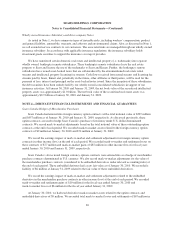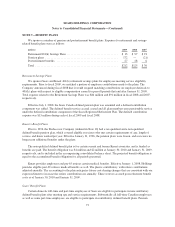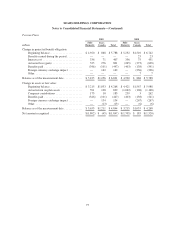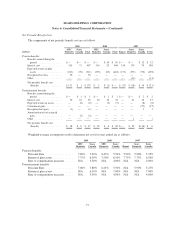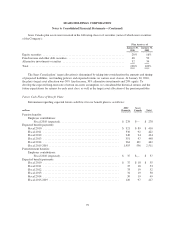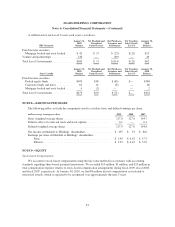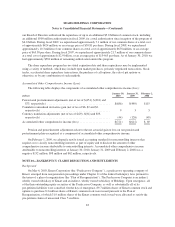Sears 2009 Annual Report Download - page 78
Download and view the complete annual report
Please find page 78 of the 2009 Sears annual report below. You can navigate through the pages in the report by either clicking on the pages listed below, or by using the keyword search tool below to find specific information within the annual report.
SEARS HOLDINGS CORPORATION
Notes to Consolidated Financial Statements—(Continued)
For 2010 and beyond, the domestic weighted-average health care cost trend rates used in measuring the
postretirement benefit expense are a 10.0% trend rate in 2010 to an ultimate trend rate of 8.0% in 2014. A
one-percentage-point change in the assumed health care cost trend rate would have the following effects on the
postretirement liability:
millions
1 percentage-point
Increase
1 percentage-point
Decrease
Effect on total service and interest cost
components ................................ $ 1 $ (1)
Effect on postretirement benefit obligation ......... $23 $(20)
$76 million of the unrecognized net losses in accumulated other comprehensive income are expected to be
amortized as a component of net periodic benefit cost during fiscal 2010.
Investment Strategy
The Investment Committee, made up of select members of senior management, has appointed a
non-affiliated third party professional to advise the Committee with respect to the SHC domestic pension plan
assets. The plan’s overall investment objective is to provide a long-term return that, along with Company
contributions, is expected to meet future benefit payment requirements. A long-term horizon has been adopted in
establishing investment policy such that the likelihood and duration of investment losses are carefully weighed
against the long-term potential for appreciation of assets. The plan’s investment policy requires investments to be
diversified across individual securities, industries, market capitalization and valuation characteristics. In addition,
various techniques are utilized to monitor, measure and manage risk.
Domestic plan assets were invested in the following classes of securities (none of which were securities of
the Company):
Plan Assets as of
January 30,
2010
January 31,
2009
Equity securities ......................................................... 38% 33%
Fixed income and other debt securities ........................................ 59 61
Other .................................................................. 3 6
Total .................................................................. 100% 100%
The domestic plan’s target allocation is determined by taking into consideration the amounts and timing of
projected liabilities, our funding policies and expected returns on various asset classes. At January 30, 2010, the
plan’s target asset allocation was 40% equity and 60% fixed income. To develop the expected long-term rate of
return on assets assumption, we considered the historical returns and the future expectations for returns for each
asset class, as well as the target asset allocation of the pension portfolio.
78



